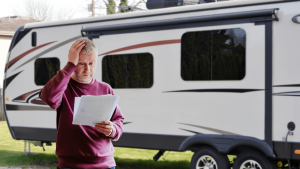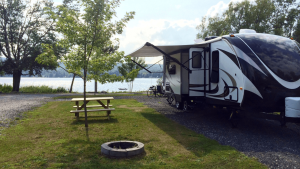Packing the right gear makes RVing safer, smoother, and less stressful. This list covers commonly recommended items that many RVers consider must-haves, especially for those just starting out. If you’re more experienced, you might still find a few things here that make your setup easier and safer.
Quick Note: Everybody’s “must-have” list will be different. After your first trip, start writing down what you used, what you didn’t, and what you wish you had. Over time, your own list will take shape based on how you travel, where you camp, and what kind of RV you use. Below are some popular items to help you get started.
Power & Electrical
When you plug into campground power, you’re relying on a system you don’t control. Voltage fluctuations, wiring issues, and unexpected surges can cause real problems. These items help protect your RV and keep things running smoothly.
EMS (Electrical Management System)
An EMS monitors the power coming from the campground pedestal and shuts it down if the voltage drops too low or spikes too high. It also detects wiring issues like open grounds or reverse polarity. These units help protect appliances and electronics from damage that could otherwise lead to expensive repairs.
Dog Bone Adapter (30A to 50A or vice versa)
Some campsites don’t offer the exact outlet your RV needs. A dog bone adapter lets you connect a 30-amp RV to a 50-amp pedestal, or the other way around. It’s a simple solution that gives you more flexibility when selecting a site.
Extension Cord (RV-rated)
Sometimes the power pedestal is just out of reach. A heavy-duty, RV-rated extension cord fills the gap. Be sure to match the amperage of your RV (30 or 50 amp) and avoid using household cords, which aren’t designed for this kind of load.
Water System
Connecting to campground water isn’t always as straightforward as hooking up a hose. Pressure can vary, fittings may not line up well, and unfiltered water could introduce sediment, and worse, harmful bacteria into your plumbing. These items help make your water setup more reliable and safer for your RV.
Drinking Water-Safe Hose (50 ft or longer)
A hose designed specifically for drinking water is made from materials that don’t leach chemicals. Look for one labeled “potable” or “drinking water safe.” Length matters too, as many sites have water connections placed far from where you’ll park, so 50 feet or more gives you the reach you may need.
Water Pressure Regulator (adjustable preferred)
City water pressure at campgrounds can range from very low to dangerously high. A water pressure regulator brings it into a safe range to avoid damaging your RV’s plumbing. Adjustable models allow you to fine-tune the pressure, which can be helpful if you’re also using a filter or softener.
Water Filter (inline or undersink style)
An inline water filter helps remove sediment and other particles before the water reaches your RV, improving water quality and keeping debris out of your water system. Inline filters are simple and install at the hose connection, while undersink systems offer more filtration options and are the preferred option if you plan to drink the water. Together, they help extend the life of your plumbing and improve water quality.
90-Degree Hose Elbow
This small fitting connects your hose to the RV at a right angle, reducing stress on the connection point. It also helps prevent kinks, especially in tight spaces where the hose bends sharply out of the inlet. A low-cost item that can prevent long-term wear.
Sewer System
Setting up the sewer line is one of those tasks that nobody looks forward to, at least I don’t, but it’s necessary. Having the right tools for the job makes it cleaner, quicker, and less stressful. These items help manage waste effectively while minimizing mess.
Sewer Hose
A dedicated RV sewer hose connects your black and gray tanks to the campsite’s sewer hookup. It needs to be durable and leak-resistant. Many RVers rely on brands like RhinoFlex, which offer flexibility and strength. Carrying at least two lengths gives you better reach when hookups are farther away.
Clear Sewer Elbow
This see-through elbow connects your sewer hose to the ground inlet. It gives you a visual cue for when your tank is empty and the rinse water runs clear. It’s not the most pleasant view, in my opinion, but it’s useful for making sure you’re flushing your system completely.
Rubber Gloves (6 mil thick)
Thick, disposable gloves are a must when handling any part of the sewer system. They help prevent contamination when connecting hoses, opening valves, or dealing with any unexpected leaks. Keep a box in an outside compartment for easy access.
Sewer Hose Support
A hose support keeps the line elevated and sloped, helping waste flow smoothly to the sewer inlet. It also prevents dips where liquids can sit and cause odors or buildup. Also, many campsites require your sewer hose to be off the ground, so having a sewer hose support just makes sense.
Tank Care
Your holding tanks require regular maintenance to function properly. Neglecting them can lead to odors, clogs, or even damage to valves and seals. These items help keep your tanks clean and your RV bathroom working the way it should.
Black Tank Treatment
Black tank treatments help control odor and assist in breaking down waste and toilet paper. Liquid or powder options are available, and many RVers find that enzyme-based or non-formaldehyde formulas work best. Using treatment regularly makes dumping easier and helps prevent buildup inside the tank.
Quick note, black tank treatments are a common recommendation, but not every RVer uses them. Some find them helpful for managing odor and breaking down waste, especially during longer stays or in hot weather. Others prefer to rely on plenty of water and regular flushing instead. I, personally, use them and like them.
Toilet Seal Conditioner
The rubber seal at the base of your RV toilet keeps water in the bowl and prevents odors from escaping the tank. If that seal dries out or cracks, you may lose that barrier. A conditioner helps keep the seal soft and working properly. It’s a small maintenance step that can prevent bigger issues later.
Tire and Road Safety
Tire issues are one of the most common causes of roadside problems for RVers. The weight of an RV, combined with long drives and varying road conditions, puts a lot of stress on tires. These tools help monitor tire health, handle emergencies, and improve safety during travel and setup.
TPMS (Tire Pressure Monitoring System)
A TPMS tracks the pressure and temperature of each tire in real time. It can alert you to slow leaks, overheating, or dangerous drops in pressure. Some systems even let you set custom alert levels for different axles. This can help prevent blowouts and other tire-related problems on the road.
Tire Pressure Gauge
Even if you have a TPMS, it’s good to carry a reliable manual gauge. It lets you double-check pressure readings and is useful during maintenance or if your monitoring system ever fails.
Air Compressor (12V)
RV and truck tires often require higher pressure than standard passenger vehicles. A 12-volt air compressor that can reach 100 PSI or more is a practical tool to carry. Some models connect directly to your RV or tow vehicle’s battery and include long hoses to reach all tires.
Rubber Wheel Chocks
Once you’re parked, chocks go behind and in front of your tires to keep the RV from rolling. Rubber chocks tend to grip better and last longer than lightweight plastic versions. Use them every time you park, especially on uneven ground.
Bottle Jack (10-ton recommended)
A bottle jack gives you the ability to lift your RV if you need to change a flat tire. Check the weight of your RV and choose a jack rated well above that to give you some margin. It’s also helpful for other minor roadside repairs.
Reflective Triangle and Safety Vest
If you’re ever stopped on the side of the road, visibility is key. A reflective triangle alerts other drivers, and a high-visibility vest helps keep you safe while working outside your RV. These items are inexpensive but can make a difference in an emergency situation.
Basic Tools and Gear
RV life often calls for quick fixes. A few key tools can make the difference between a minor inconvenience and a trip-ending problem. While you don’t need a full workshop, having the right basics on hand helps you handle common issues on the road or at the campsite.
Breaker Bar and Socket Set
A breaker bar gives you the leverage needed to loosen tight lug nuts, especially on trailer or truck tires. Pair it with a socket set that matches the sizes used on your RV and tow vehicle. It’s a must if you plan to change a tire yourself.
Basic Tool Kit
A compact tool kit should include screwdrivers, pliers, an adjustable wrench, a utility knife, and other commonly used tools. You don’t need a huge set, but having the right tool when something loosens, leaks, or rattles can save you time and frustration.
Work Gloves
Good gloves protect your hands during setup, tear-down, and repairs. They also give you a better grip when handling rough or dirty items, like leveling blocks, sewer hoses, or cargo.
Flashlight and Headlamp
Lighting helps in low-visibility situations, from late-night arrivals to working in dark compartments. A flashlight is useful, but a headlamp lets you work hands-free. Keep both types on board so you’re prepared in different scenarios.
Fuses (spares)
RV systems rely heavily on fuses, and they can blow without warning. Carry a range of spares that match the types used in your RV. Having them on hand can help you restore power to lights, slides, or appliances without a trip to the store.
Comfort and Setup
Once your RV is parked and hooked up, the next step is making the space stable, safe, and livable. These items help with leveling, comfort, and basic safety, things that make daily life in your RV a little easier.
Leveling Ramps or Blocks
Even if your RV has an automatic leveling system, ramps or blocks can still be useful. They help keep tires on the ground when leveling and provide a stable base on soft surfaces. For trailers without auto-leveling, they’re a standard part of every setup.
Manual Level (or electronic)
A level helps you check that your RV is sitting evenly front to back and side to side. Some people use small bubble levels mounted inside cabinets, while others prefer electronic indicators. Either way, staying level is better for your appliances and makes moving around inside more comfortable.
First Aid Kit (for RV and tow vehicle)
Accidents happen, and having basic first aid supplies nearby is a smart move. It’s best to keep one kit in the RV and another in your tow vehicle so you’re covered at the campsite or on the road. Stock them with bandages, antiseptics, and other standard items.
Fire Extinguisher (2.5 lb ABC)
Many RVs come with a small fire extinguisher, but they’re often undersized or poor quality. A 2.5-pound ABC extinguisher covers most fire types you might face in an RV, including electrical, grease, and combustible materials. Check it periodically to make sure it’s still charged.
What Would You Add?
Everyone’s RV setup is a little different. If there’s an item you always bring along or something you think we missed, share it in the comments. Your recommendation could help someone have a smoother trip.

































For us, the Magnashades are a real plus at cooling the interior
A GFI tester is handy to have
An 8 ft ladder always help to git to things on the roof
Roof ladder, a Y for water connection at the spigot, a fire blanket or 2 (one inside one outside) rug for outside, a foldable table for outside cooking space.